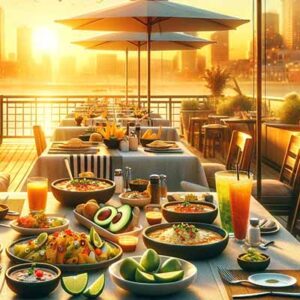Artistry on a Plate: The Intricate World of Bento Boxes - Henderson Edition
2024.7.25
by Min Kim
Japanese Cuisine
Japanese food is renowned not only for its accuracy but also for its aesthetics and respect for tradition; often a piece of art in its making, a plate of food. Out of the many different facets which can be found in Japanese cuisine, the bento box takes on the mantle of being one of the most singular and endearing pieces. A bento is not just a meal; it is most importantly an expression of the aesthetic sense of balance and nutrition in its edible form. This article will further discuss bento boxes, their history, meaning within the culture, and how they are intricately prepared.
Bento finds its origin almost at the time of the Kamakura period (1185-1333), when cooked and dried rice, or *hoshi-ii*, was carried in bags. Later on, during the Edo period (1603-1868), bento boxes would also become more elaborate with their lacquered wood containers and numbers of food items increased. These early versions of bentos were put into play among a variety of different uses: on tea parties, when going to theaters, and on travels, slowly finding their way into tradition.
Japanese bento is more than just the rationing of an easy meal; it is entirely symbolic of wholesome upbringing, tradition, and even social mores. Hence, preparing a bento for a child, spouse, or friend is an act of love and thoughtfulness. Each bento is a laboriously created balanced meal, as pleasing to the eye as it is satisfying to one’s hunger. The tradition epitomizes a core of Japanese culture: finding harmony, balance in diet as in life.
A classic bento box has a variety of carbohydrates, proteins, and vegetables in it, all artistically arranged so it looks quite appetizing and healthy. Common components include:
1. Rice: This is considered a staple in bentos. It can be prepared and served simply, flavored, or formed into onigiri- nifty little rice bundle (into balls). Sometimes, it is topped with furikake-seasoning or mixed with vegetables or seafood.
2. Protein: This can be a variety of things from grilled fish, chicken, and beef to tamagoyaki (a rolled omelet) or tofu. Every item of protein would be prepared in such a way as to best fit the rest of the things in the box.
3. Vegetables: Seasonal and most often pickled or lightly cooked to retain their crispness and color, they add to both the nutrition and brilliant hues of the bento box.
4. Pickles: Called *tsukemono*, they provide a sour contrast to the other ingredients and aid in the digestion of the other foods.
5. Fruit: A small amount of fresh fruit frequently contributes the final touch of sweetness at meal’s end.
The presentation of a good bento box is not only the taste but also the aesthetics. In fact, Japanese cuisine puts a lot of importance on food aesthetics, which is more than clearly reflected in bento boxes. The perfect choice of a balanced color, symmetry, and seasonal ingredients subdue the eye. All these are underlain by the Zen doctrine of shun, pertinent to seasonality, so each bento reflects the current season by ingredients and presentation.
Bentōshokunin, or bento artists, bring this modest meal of daily routine to new highs with divergent techniques. It is used by them to make complex designs usually referring to nature, festivals, and popular culture. The creativity, involved to make bento, has no limits from simple patterns to detailed scenes of characters from folklore or any modern media.
In modern Japan, bento has kept its traditional features and accommodated the conditions of modern life. The most common in the country may become the majority of ready-made *konbini* bento, which do try not to lose the balance and quality native to homemade dishes.
Homemade bentos are still the standard for many, parents preparing the meal for the children to take into school. Making a bento can be a real family affair, instilling in kids the importance of nutrition, cooking, and pride in the meals they eat.
On the other hand, social media became a new battlefield of this bento artistry. It turned bento making into interactive hobbies with the trend of *kyara-ben*, Character bentos which portrays famous characters in a complex image where bento makers share their works online. This has certainly ignited interest in making bento across the world, luring people to try out this very Japanese art of food preparation.
The bento box has transcended the borders of Japan and has now become popular in many countries around the world in many ways. Nowadays, one will find Japanese, non-Japanese, or even fusion restaurants and food shops selling bento boxes. Second, the bento principles of balance, beauty, and care in preparation have caused ripple effects outward to connect into the zeitgeist of other global food trends in healthful and thoughtful cuisine.
International bento adaptations very often incorporate local ingredients and flavors into a fusion which is respectful to the original concept, yet with a regional twist. This intercultural barter shall bring dignity to the host cuisine and the traditional nature of bento, showing how flexible this form of Japanese culinary art is in terms of global appeal.
As lifestyles continue to change, so too will the likely change in the bento box, while at the same time hopefully maintaining its core values of balance, beauty, and care. Innovations in food technology and sustainability may trickle down to influence bento making, from new materials for the box to eco-friendly packaging. But the bento, a meal made lovingly and appealingly, arranged in a nutritionally balanced manner, will never change.
Simply, the bento box epitomizes Japanese culinary artistry. The bento captures an arrangement which is balanced, seasonally appropriate, and visually harmonious with the essence of the meal, welcoming the eye as much as it will the taste buds. Whether savored in a very traditional setting or modernized for convenience, the bento box still captivates and inspires generation after generation, really solidifying this Japan born form of food transportation as supreme in culture and class for its timelessness in representing good taste.
1stHendersonGuide.com

We List Only the Best
1st Henderson Guide is not a list of every business. Our website highlights only the best businesses / places / events are featured within these pages. This makes Henderson even more magical for residents and visitors alike.

Advertise Your Company
You can be seen by a high quality audience when you place an advertisement on 1st Henderson Guide. Not all companies are accepted… Call 702-445-9488 to be have your company seen by affluent buyers. You will be amazed how with the low price.

1st City Guide Expansion
1stCityGuide.com is the parent company of 225+ city guides worldwide. We are expanding and looking for Licensee partners to work together and provide a quality income when sharing the secrets of great cities around the world with visitors and residents alike. Call 702-210-4201 to discuss pricing and city guide availabilities.
